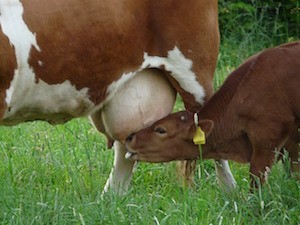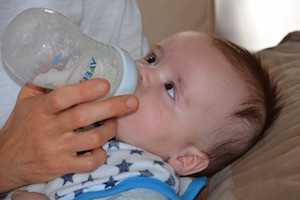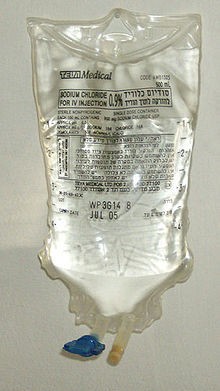Differences between breast milk and cow's milk
Without any doubt even conventional medicine agrees to it: breast milk is the best for babies. But how detrimental could the formula milk be?

Although the infant formula tries to mimic breast milk to the maximum, it is impossible for it to have the same nutritional effect.
First of all, formula milk is synthesized from cow's milk. Let us compare the main differences between these milks (2):
1.- The proportion of whey and casein proteins of human milk (30% casein, 70% whey) differs from that in bovine milk (82% casein, 18% whey). The soluble proteins in the whey fraction are more easily digested and tend to facilitate more rapid gastric emptying.
The types of proteins contained in the whey fraction differ between human and bovine milks. The major human whey protein is α-lactalbumin. The major whey protein in cow’s milk is β-lactoglobulin.
So human milk is low in protein, at least when compared with the milk of other species, especially cow’s milk. Human infants are designed to grow slowly. While it’s important for humans to develop strong bodies, even more important is brain development and the learning of social skills. (10)
2.- Lactoferrin, lysozyme, and immunoglobulin A are specific human whey proteins involved in host defense. Because these host-defense proteins resist proteolytic digestion, they are capable of a first line of defense by lining the gastrointestinal tract.
The three host defense proteins are essentially absent in cow’s milk.
3.- The pattern of fatty acids in human milk is also unique in its composition of very long chain fatty acids. Arachidonic acid (AA) and docosahexaenoic acid (DHA), derivatives of linoleic and linolenic acids, respectively, are found in human but not bovine milk. Arachidonic and docosahexaenoic acids functionally have been associated with cognition, growth, and vision.
 4.- Human breast milk, unlike cow’s milk, contains significant quantities of oligosaccharides. Milk oligosaccharides exert important prebiotic functions by promoting the colonisation of the intestine by beneficial bacteria.
4.- Human breast milk, unlike cow’s milk, contains significant quantities of oligosaccharides. Milk oligosaccharides exert important prebiotic functions by promoting the colonisation of the intestine by beneficial bacteria.5.- The fat in human milk comes with an enzyme, lipase, that breaks the fat down into smaller globules so this important nutrient can be better absorbed into the bloodstream. Cow milk doesn’t contain lipase.
6.- Vitamins A, C and E are five times more significant in breast milk. In general, all vitamins and minerals have a higher absorption rate in breast milk, and in the case of iron it is even 10 times higher.
7.- In human milk Epidermal Growth factor (EGF) is the most active growth factor, with insulin and Insulin-like-Growth-Factor-1 (IGF-1) playing smaller roles. Cow's milk has no EGF. IGF-I in bovine colostrum exceeds 1000 μg/l compared with 17 μg/l and 6.8 μ/l in human colostrum and mature milk respectively. Bovine milk lacks colony stimulating factor.
Infant formula
The baby food producing industry is constantly investigating how to reproduce breast milk in the laboratories, however, they are still very far from reaching this goal.
What processes is cow's milk subjected to in order to be transformed into infant formula milk?
Milk consists of milk protein, fat, sugar, minerals, salts, vitamins and minerals.
Formula milk is made by mixing similar substances in order to imitate most of the characteristics of human milk.
Basically, the performed industrial processes are: (10)
 1.- Part of the casein is replaced by whey protein. The whey protein of the formula contains beta-lactoglobulin as well as serum albumin and immunoglobulin G in a lower concentration. In contrast, breast milk contains alpha-lactalbumin, lactoferrin, lysozyme and immunoglobulins.
1.- Part of the casein is replaced by whey protein. The whey protein of the formula contains beta-lactoglobulin as well as serum albumin and immunoglobulin G in a lower concentration. In contrast, breast milk contains alpha-lactalbumin, lactoferrin, lysozyme and immunoglobulins.2.- Cow's milk is low in lactose; and so, the first stage in the "humanizing' of cow's milk is to increase the sugar content. This is done either by adding more lactose or other sugars like sucrose, fructose, glucose and maltodextrin.
3.- Natural fats in cow's milk, which are indigestible for a baby, are replaced by vegetable fats, that are rich in inflammatory omega-6. These are extracted from fish or from the lecithin of the egg yolk, and in this case there is a possible contamination of the highly allergenic egg proteins.
4.- Vitamins and trace elements are added, but not always in their most easily digestible form.
5.- Other commonly used ingredients are some additifs such as emulsifiers and stabilizers added to prevent the separation of the oil from the water, and diluents such as skim milk and purified water.

6.- The resulting formula is subjected to pasteurization, homogenization, sterilization and standardization. During these thermal processes denaturation of proteins that provide immunological benefits occurs, retaining allergen susceptibility that can induce beta-lactoglobulin. These processes also involve the appearance of trans fatty acids from vegetable oils. Currently the European Commission limits trans fatty acids in infant formula to 4% of total fatty acids. However, it is a proved fact that trans fatty acids are highly detrimental to health and should be completely excluded from the diet of any person. (10)
As the lipase is heat-labile, it is important to recognize that the superior fat absorption from human milk is reported only when unprocessed milk is fed.
The exact final formula depends on each manufacturer.
“The attempts of the food chemist to modify the milk of one mammal, the cow, for feeding another, the human infant, have been largely unsuccessful, notwithstanding the claims made in the promotional literature. The reasons are obvious. It is not just the question of adding a sugar to get the carbohydrate content right, or of diluting to get the protein content right, nor of replacing butter fat with a mixture of vegetable oils. The entire structure of the protein in human milk is so very different from that in cow's milk . The fatty acid composition is unique for each mother and so also are the electrolytes and trace elements“ (13)
Soya is very rich in feminine hormones, isoflavones. The Suisse Federal Office for Public Health (OFSP) advises against soya milk for babies and young children, and suggests limiting consumption to one or two portions a day for older children and adults.
The properties of soya are a cause of much controversy. Some scientists consider them carcinogenic, disruptive to hormones and thyroid, but the main dispute is due to the content of phytohormones (isoflavones), phytic acid, hemaglutinine and goitrogen.
The resulting formula milk is thus an industrially processed food which contains chemicals, even more than industrially processed food for adults.
As a result, it is proved that the health of breastfed infants is much better than those fed on formula milk, due to several factors:
 1.- Breast milk contains numerous immunostimulants that compensate for the immature nature of the newborn’s immune defense mechanisms. Immunoglobulins A provided by breast milk protect babies’ mucosal surfaces, who are unable to do it correctly by themselves. (1) That is why the combination of early lactation and formula milk is known to cause allergy to milk.
1.- Breast milk contains numerous immunostimulants that compensate for the immature nature of the newborn’s immune defense mechanisms. Immunoglobulins A provided by breast milk protect babies’ mucosal surfaces, who are unable to do it correctly by themselves. (1) That is why the combination of early lactation and formula milk is known to cause allergy to milk.2.- Breast milk also protects infants against chromosomal abnormalities. (1)
3.- Some studies relate infant early ingestion of cow’s milk with Type 1 diabetes due to the fact that it contains bovine insulin. (1),(4).
4.- The risk of sudden death is 2-5 times higher in formula milk-fed babies. (5)
5.- Breast milk and breastfeeding promotes proper brain and intellectual development of infants. (5)
6.- Breastfed babies fall asleep more easily. (5)
7.- Regurgitations are much lower in breastfed infants because breast milk is digested much faster and, therefore, the stomach gets emptied more quickly. (5)
8.- Formula milk fed babies have diarrhea 2 times more. (5)
An important consideration to keep in mind is the composition of breast milk when the mother drinks cow's milk. Not all milk proteins are well digested and some of them reach the intestinal mucosa in significant amounts and may be absorbed intact by the body. Thus, the breast milk of mothers who consume cow's milk contains certain amounts of beta-lactoglobulin from the cow. A baby’s exclusion of cow’s milk also means the nursing mother’s abstinence of all dairy products and all sources of animal milk protein.
Some adulteration scandals of infant formula have come to light, such as the melamine scandal in China in 2008, the scandal of ink contamination in infant formula at Nestlé in Italy, France, Portugal and Spain in 2005, outbreaks of salmonellosis in 2008 and 2010 at Novalac milk, etc.
But what if the mother can not breastfeed?
 A mother may either not have enough milk or she can not breastfeed for various other reasons. The effect of epidurals on breastfeeding will be explained in the next section.
A mother may either not have enough milk or she can not breastfeed for various other reasons. The effect of epidurals on breastfeeding will be explained in the next section.It is preferred to go to a nursing mother who can breastfeed naturally, as people did in earlier times when a mother could not breastfeed, or otherwise, go to milk banks in hospitals, such as the Doce de Octubre in Madrid. (3)
The advantage of a nursing mother's milk is that it is"fresh" and therefore all its nutrients are intact. It is advisable to learn about the customs of the nursing mother: their food, smoking and drinking habits, etc. On the contrary, breast milk in milk banks has been pasteurized and extracted long ago, so many nutrients such as enzymes, antibodies and vitamins are destroyed or altered. Even so, it is infinitely superior to formula milk.
The advantage of the milk bank is that the mother can give her baby the milk bottle herself, so an important emotional bond that would be normally established during breastfeeding can be established this way.
The effects of the epidural anesthesia
In a study on epidural analgesia and breastfeeding, infants whose mothers had no labor analgesia scored higher on the breastfeeding scale than mothers who had epidurals or intravenous narcotics. (6) Another study found that 67% of women who had an epidural reported partial or full formula-feeding in the first 12 weeks compared to only 29% of women who had not. Mothers who had an epidural were also more likely to report having ‘not enough milk’. (7)
 There is evidence to show that epidural anesthesia probably does diminish the neonate's early ability to suckle.
There is evidence to show that epidural anesthesia probably does diminish the neonate's early ability to suckle.The effect of epidurals on the newborn is dosage and time-dependent. In general, the greater the medication dosage the more pronounced the alteration in neonatal function. However, this relationship is neither simple nor uniform as it is affected by the newborn's ability to metabolize or excrete the medication.(6)
Three other studies, examined labor epidurals and general neonatal behavior with differing results. Infants in epidural groups performed less well on the motor, state control, and physiologic response clusters of the Brazelton Neonatal Behavior Assessment Scale than the little-or-no-medication group. On the fifth day the babies in the epidural groups continued to show poor state organization. (6)
Epidurals increase the risk of instrumental delivery, can cause a fever in women in labour and often cause a drop in blood pressure and the baby may be born with more fluid. This might falsely inflate a baby’s birth weight. When he sheds this fluid, he might appear to lose more weight than ‘allowed. This might dent a mother’s confidence in breastfeeding.(9)
Epidural labor analgesia is only one of the many intrapartum interventions that may affect breastfeeding. Interventions such as maternal intravenous fluids, vacuum extraction, operative deliveries, and infant oral suctioning may also alter suckling. The use of synthetic oxytocin has been linked to an increase number of bottle-feeds and a shorter length of breastfeeding. This may be because it disrupts the release of natural oxytocin and increases the need for intravenous fluids. Skin-to-skin contact with your baby after the birth will help overcome any disruption to the natural release of oxytocin. (7)
Colic and gastro-oesophageal reflux
Out of all the events that occur in the case of newborn babies, perhaps colic and reflux are the most frequent ones.

The cramps are severe pain in the tummy and reflux is the regurgitation of ingested milk. The treatment offered by conventional medicine is antacids to reflux and colic drops to the cramps. Antacids alleviate the problem temporarily, but by inhibiting the secretion of hydrochloric acid in the stomach, they eventually make the digestion become worse.
There are also many natural remedies for colic and reflux ranging from warm water bags, massages, putting the baby in certain positions, etc., to certain herbs. However, the best option is to find the cause of their occurrence and this way avoid them.
From the viewpoint of functional medicine the main cause of these two problems is intestinal dysbiosis, certain bacterial overgrowth in the intestine strains, which produce excessive amounts of gas.
A baby, before being born is sterile. When arriving at birth, the baby receives its first dose of microbes to pass through the birth canal. Its skin, eyes and mucous membranes of the mouth and nose acquire their first microflora. The baby's digestive system gets its first population of bacterias, viruses and fungi through the liquids it swallows in the mother's vagina. So whatever lives in the mother's vagina, that is what the baby receives and it will populate the gut of the newborn, forming its intestinal flora. And vaginal microflora originates in the intestine. (12) Thus, the primary cause of an imbalance in the infant's intestinal flora is due to maternal dysbiosis.
However, it may also be due to inadequate nutrition with formula milk that contains harmful sugars and starches;
There are also many natural remedies for colic and reflux ranging from warm water bags, massages, putting the baby in certain positions, etc., to certain herbs. However, the best option is to find the cause of their occurrence and this way avoid them.
From the viewpoint of functional medicine the main cause of these two problems is intestinal dysbiosis, certain bacterial overgrowth in the intestine strains, which produce excessive amounts of gas.
A baby, before being born is sterile. When arriving at birth, the baby receives its first dose of microbes to pass through the birth canal. Its skin, eyes and mucous membranes of the mouth and nose acquire their first microflora. The baby's digestive system gets its first population of bacterias, viruses and fungi through the liquids it swallows in the mother's vagina. So whatever lives in the mother's vagina, that is what the baby receives and it will populate the gut of the newborn, forming its intestinal flora. And vaginal microflora originates in the intestine. (12) Thus, the primary cause of an imbalance in the infant's intestinal flora is due to maternal dysbiosis.
However, it may also be due to inadequate nutrition with formula milk that contains harmful sugars and starches;
allergen proteins or other inappropriate compounds that babies can not digest. Another common cause is overfeeding the baby when the breast or the bottle are used to calm it down while the baby's actual needs are different: fatigue, sleep, boredom, need for love, dirty diapers, heat or cold, etc.
If the baby is breastfed and has colic or other problems the mother should also think about whether her diet is correct: if she is eating intolerant foods that may create inflammation or she takes certain medications, etc. All these factors may affect the baby.
 These problems may also be due to many other causes, such as excessive air swallowing or stress. Babies are very sensitive to family problems, conflict situations create a kind of stress that can affect them a lot and may also be the cause.
These problems may also be due to many other causes, such as excessive air swallowing or stress. Babies are very sensitive to family problems, conflict situations create a kind of stress that can affect them a lot and may also be the cause.
In addition to examining the possible causes as well as a corresponding change in the baby's feeding and the mother's diet if necessary, the ingestion of probiotics should also be considered.
Certain analyses as the mother's gut flora and food intolerances analyses may be helpful in the final diagnosis.
The allergy to cow's milk can cause abdominal pain or cramps, soft or loose stools (which may be bloody), constipation, vomiting, reflux, dermatitis as symptoms and manifestation occurs shortly after ingestion, only minutes or a few hours afterwards. They usually appear several days or weeks after introducing milk made with cow's milk.
Allergy to cow's milk is due to a reaction to any of the milk proteins: casein, beta-lactoglobulin and alpha-lactalbumin, the first two being the most likely to be the cause (1) The pediatrician often makes a test that measures IgE antibodies to determine if the baby has an allergy to cow's milk when these symptoms occur.
.jpg) Conversely, casein intolerance, which is one of the proteins of cow's milk, provides a wide range of symptoms, and the time it takes to manifest is much longer, ranging from a few hours to several days. That is why it is much harder to detect, although there are different analyses in order to detect them which are based on measuring IgG antibodies to casein. In the case of adults, the effects of intolerance to cow's milk protein are diseases such as osteoporosis, anemia, auto-immunity (diabetes, psoriasis, multiple sclerosis, thyroiditis, etc.), atopy (allergy, asthma, dermatitis, etc.) inflammation (rheumatism, fibromyalgia, Crohn's disease, etc.), gastro-intestinal disturbances (constipation, diarrhea, reflux, etc.). In children and babies these effects might be anemia, diabetes and atopy, but most frequently they are gastro-intestinal diseases: colic, constipation, diarrhea, reflux, etc. (1) This type of intolerance is never examined by pediatricians.
Conversely, casein intolerance, which is one of the proteins of cow's milk, provides a wide range of symptoms, and the time it takes to manifest is much longer, ranging from a few hours to several days. That is why it is much harder to detect, although there are different analyses in order to detect them which are based on measuring IgG antibodies to casein. In the case of adults, the effects of intolerance to cow's milk protein are diseases such as osteoporosis, anemia, auto-immunity (diabetes, psoriasis, multiple sclerosis, thyroiditis, etc.), atopy (allergy, asthma, dermatitis, etc.) inflammation (rheumatism, fibromyalgia, Crohn's disease, etc.), gastro-intestinal disturbances (constipation, diarrhea, reflux, etc.). In children and babies these effects might be anemia, diabetes and atopy, but most frequently they are gastro-intestinal diseases: colic, constipation, diarrhea, reflux, etc. (1) This type of intolerance is never examined by pediatricians.
What pediatricians call an intolerance to cow's milk is an inability to digest lactose, the sugar in milk, but they do not consider the delayed hypersensitivity (not to be confused with an allergy) to milk proteins. Casein intolerance is fairly common in babies, while lactose intolerance is quite unlikelyin their case.
 I would recommend the mother to prepare as soon as possible, before conception if possible. It is advisable to any woman who has any kind of health problem, however small it may seem, to check her diet. If she has any health problem, that may be caused by different factors such as the lack of nutrients, intestinal dysbiosis, an inflammatory process, toxic exposure, etc., all of which may affect significantly the development of the baby during pregnancy and breastfeeding.
I would recommend the mother to prepare as soon as possible, before conception if possible. It is advisable to any woman who has any kind of health problem, however small it may seem, to check her diet. If she has any health problem, that may be caused by different factors such as the lack of nutrients, intestinal dysbiosis, an inflammatory process, toxic exposure, etc., all of which may affect significantly the development of the baby during pregnancy and breastfeeding.
In case she is perfectly healthy, probably her diet is good enough.
Other aspects that affect health should also be taken into account during pregnancy: the emotional state, exercise, rest, sleep, sun exposure, etc
.
 I will not elaborate on this section because I could write numerous and extensive articles about the topic. I just advise you to be well informed about the advantages and disadvantages of vaccines in alernative studies. I include some links that I consider interesting on the subject.
I will not elaborate on this section because I could write numerous and extensive articles about the topic. I just advise you to be well informed about the advantages and disadvantages of vaccines in alernative studies. I include some links that I consider interesting on the subject.
Links
* http://www.efvv.eu/
* libro “Vaccinations: les vérités indésirables”, Michel Georget
* http://www.nvic.org/
* http://www.info-vaccination.be/?La-composition-des-vaccins-Dr-Jean-PILETTE
* http://tv.naturalnews.com
* http://www.info-vaccination.be
References
(1) “Ecosystème intestinal & Santé optimale”, Dr. Georges Mouton
(2) "Production of powdered baby food", GEA Process Engineering Inc.
(3) "Nodrizas del siglo XXI: madres que donan su leche para ayudar a criar a bebés prematuros" , 20 minutos
(4) "Wheat and Dairy", Diabetes and the Environment
(5) "Benefits of BreastMilk" , Ask Dr. Sears
(6) "Epidurals and breastfeeding", Australian Breastfeeding Association
(7) Volmanen P, Valanne J, Alahuhta S 2004, “Breast-feeding problems after epidural analgesia for labour: a retrospective cohort study of pain, obstetrical procedures and breast-feeding practices”. Int J Obstet Anesth 13(1): 25–9
(8) Garcia-Fortea P, Gonzalez-Mesa E, Blasco M, Cazorla O, Delgado M, Gonzalez-Valenzuela MJ 2013, “Oxytocin administered during labor and breastfeeding: A retrospective cohort study”. J Matern Fetal Neonatal Med
(9) "Epidurals and breastfeeding", La Leche League
(10) "FÓRMULAS LÁCTEAS INFANTILES PARA LA ALIMENTACIÓN DEL LACTANTE SANO DURANTE EL PRIMER AÑO DE VIDA."
(11) "Fórmulas adaptadas para lactantes y modificaciones actuales de éstas"
(12) “Gut and Psychology Syndrome”, Dr. Natascha Campbell-McBride.
If the baby is breastfed and has colic or other problems the mother should also think about whether her diet is correct: if she is eating intolerant foods that may create inflammation or she takes certain medications, etc. All these factors may affect the baby.
 These problems may also be due to many other causes, such as excessive air swallowing or stress. Babies are very sensitive to family problems, conflict situations create a kind of stress that can affect them a lot and may also be the cause.
These problems may also be due to many other causes, such as excessive air swallowing or stress. Babies are very sensitive to family problems, conflict situations create a kind of stress that can affect them a lot and may also be the cause.In addition to examining the possible causes as well as a corresponding change in the baby's feeding and the mother's diet if necessary, the ingestion of probiotics should also be considered.
Certain analyses as the mother's gut flora and food intolerances analyses may be helpful in the final diagnosis.
Intolerances and allergies to milk
The allergy to cow's milk can cause abdominal pain or cramps, soft or loose stools (which may be bloody), constipation, vomiting, reflux, dermatitis as symptoms and manifestation occurs shortly after ingestion, only minutes or a few hours afterwards. They usually appear several days or weeks after introducing milk made with cow's milk.
Allergy to cow's milk is due to a reaction to any of the milk proteins: casein, beta-lactoglobulin and alpha-lactalbumin, the first two being the most likely to be the cause (1) The pediatrician often makes a test that measures IgE antibodies to determine if the baby has an allergy to cow's milk when these symptoms occur.
.jpg) Conversely, casein intolerance, which is one of the proteins of cow's milk, provides a wide range of symptoms, and the time it takes to manifest is much longer, ranging from a few hours to several days. That is why it is much harder to detect, although there are different analyses in order to detect them which are based on measuring IgG antibodies to casein. In the case of adults, the effects of intolerance to cow's milk protein are diseases such as osteoporosis, anemia, auto-immunity (diabetes, psoriasis, multiple sclerosis, thyroiditis, etc.), atopy (allergy, asthma, dermatitis, etc.) inflammation (rheumatism, fibromyalgia, Crohn's disease, etc.), gastro-intestinal disturbances (constipation, diarrhea, reflux, etc.). In children and babies these effects might be anemia, diabetes and atopy, but most frequently they are gastro-intestinal diseases: colic, constipation, diarrhea, reflux, etc. (1) This type of intolerance is never examined by pediatricians.
Conversely, casein intolerance, which is one of the proteins of cow's milk, provides a wide range of symptoms, and the time it takes to manifest is much longer, ranging from a few hours to several days. That is why it is much harder to detect, although there are different analyses in order to detect them which are based on measuring IgG antibodies to casein. In the case of adults, the effects of intolerance to cow's milk protein are diseases such as osteoporosis, anemia, auto-immunity (diabetes, psoriasis, multiple sclerosis, thyroiditis, etc.), atopy (allergy, asthma, dermatitis, etc.) inflammation (rheumatism, fibromyalgia, Crohn's disease, etc.), gastro-intestinal disturbances (constipation, diarrhea, reflux, etc.). In children and babies these effects might be anemia, diabetes and atopy, but most frequently they are gastro-intestinal diseases: colic, constipation, diarrhea, reflux, etc. (1) This type of intolerance is never examined by pediatricians.What pediatricians call an intolerance to cow's milk is an inability to digest lactose, the sugar in milk, but they do not consider the delayed hypersensitivity (not to be confused with an allergy) to milk proteins. Casein intolerance is fairly common in babies, while lactose intolerance is quite unlikelyin their case.
Preparation for giving birth
 I would recommend the mother to prepare as soon as possible, before conception if possible. It is advisable to any woman who has any kind of health problem, however small it may seem, to check her diet. If she has any health problem, that may be caused by different factors such as the lack of nutrients, intestinal dysbiosis, an inflammatory process, toxic exposure, etc., all of which may affect significantly the development of the baby during pregnancy and breastfeeding.
I would recommend the mother to prepare as soon as possible, before conception if possible. It is advisable to any woman who has any kind of health problem, however small it may seem, to check her diet. If she has any health problem, that may be caused by different factors such as the lack of nutrients, intestinal dysbiosis, an inflammatory process, toxic exposure, etc., all of which may affect significantly the development of the baby during pregnancy and breastfeeding.In case she is perfectly healthy, probably her diet is good enough.
Other aspects that affect health should also be taken into account during pregnancy: the emotional state, exercise, rest, sleep, sun exposure, etc
.
Vaccines
 I will not elaborate on this section because I could write numerous and extensive articles about the topic. I just advise you to be well informed about the advantages and disadvantages of vaccines in alernative studies. I include some links that I consider interesting on the subject.
I will not elaborate on this section because I could write numerous and extensive articles about the topic. I just advise you to be well informed about the advantages and disadvantages of vaccines in alernative studies. I include some links that I consider interesting on the subject.Links
* http://www.efvv.eu/
* libro “Vaccinations: les vérités indésirables”, Michel Georget
* http://www.nvic.org/
* http://www.info-vaccination.be/?La-composition-des-vaccins-Dr-Jean-PILETTE
* http://tv.naturalnews.com
* http://www.info-vaccination.be
References
(1) “Ecosystème intestinal & Santé optimale”, Dr. Georges Mouton
(2) "Production of powdered baby food", GEA Process Engineering Inc.
(3) "Nodrizas del siglo XXI: madres que donan su leche para ayudar a criar a bebés prematuros" , 20 minutos
(4) "Wheat and Dairy", Diabetes and the Environment
(5) "Benefits of BreastMilk" , Ask Dr. Sears
(6) "Epidurals and breastfeeding", Australian Breastfeeding Association
(7) Volmanen P, Valanne J, Alahuhta S 2004, “Breast-feeding problems after epidural analgesia for labour: a retrospective cohort study of pain, obstetrical procedures and breast-feeding practices”. Int J Obstet Anesth 13(1): 25–9
(8) Garcia-Fortea P, Gonzalez-Mesa E, Blasco M, Cazorla O, Delgado M, Gonzalez-Valenzuela MJ 2013, “Oxytocin administered during labor and breastfeeding: A retrospective cohort study”. J Matern Fetal Neonatal Med
(9) "Epidurals and breastfeeding", La Leche League
(10) "FÓRMULAS LÁCTEAS INFANTILES PARA LA ALIMENTACIÓN DEL LACTANTE SANO DURANTE EL PRIMER AÑO DE VIDA."
(11) "Fórmulas adaptadas para lactantes y modificaciones actuales de éstas"
(12) “Gut and Psychology Syndrome”, Dr. Natascha Campbell-McBride.
 Currently most of our babies are born enjoying good health. However, some of them do cry non-stop for hours, sleep little, eat too little or eat too often, have problems with reflux or vomiting, become sick on first exposure to the virus of their siblings, have dermatitis, conjunctivitis and various infections; and we still have not mentioned premature babies and other worrisome conditions like jaundice, febrile convulsions, etc. Regarding the mother, she often does not have enough milk to breastfeed and needs a supplementary feeding bottle, moreover, there may be frequent complications of childbirth and the cesarean rate is rising more and more, etc.
Currently most of our babies are born enjoying good health. However, some of them do cry non-stop for hours, sleep little, eat too little or eat too often, have problems with reflux or vomiting, become sick on first exposure to the virus of their siblings, have dermatitis, conjunctivitis and various infections; and we still have not mentioned premature babies and other worrisome conditions like jaundice, febrile convulsions, etc. Regarding the mother, she often does not have enough milk to breastfeed and needs a supplementary feeding bottle, moreover, there may be frequent complications of childbirth and the cesarean rate is rising more and more, etc.







 Gemma Calzada is a Holistic Nutritionist Ph.D. and a certified GAPS practitioner, accredited by ASCA. Her mission is to improve health through nutrition and to help people suffering from a dietary intolerance to live happily.
Gemma Calzada is a Holistic Nutritionist Ph.D. and a certified GAPS practitioner, accredited by ASCA. Her mission is to improve health through nutrition and to help people suffering from a dietary intolerance to live happily. 
